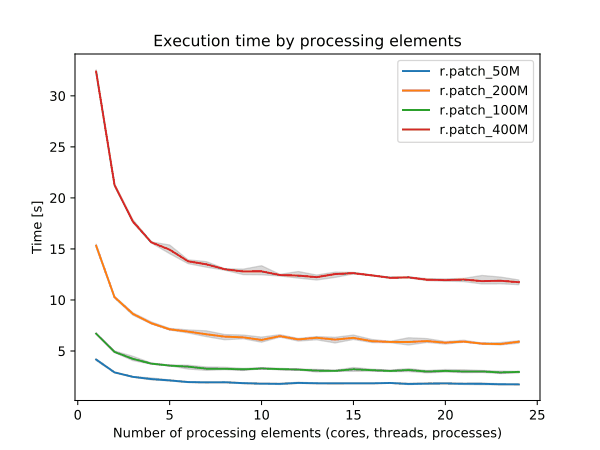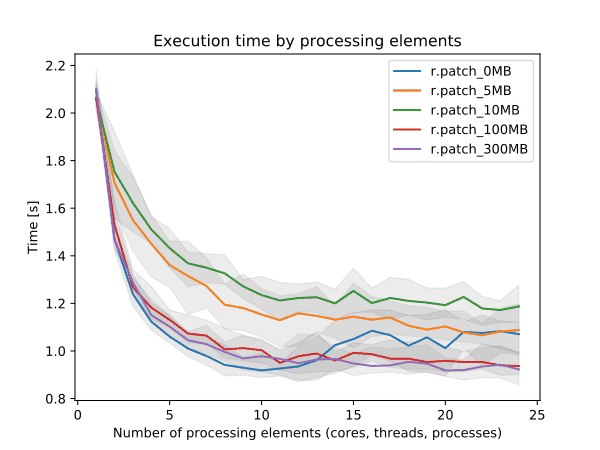r.patch
Creates a composite raster map layer by using known category values from one (or more) map layer(s) to fill in areas of "no data" in another map layer.
r.patch [-zs] input=name [,name,...] output=name [nprocs=integer] [memory=memory in MB] [--overwrite] [--verbose] [--quiet] [--qq] [--ui]
Example:
r.patch input=name output=name
grass.script.run_command("r.patch", input, output, nprocs=0, memory=300, flags=None, overwrite=None, verbose=None, quiet=None, superquiet=None)
Example:
gs.run_command("r.patch", input="name", output="name")
grass.tools.Tools.r_patch(input, output, nprocs=0, memory=300, flags=None, overwrite=None, verbose=None, quiet=None, superquiet=None)
Example:
tools = Tools()
tools.r_patch(input="name", output="name")
This grass.tools API is experimental in version 8.5 and expected to be stable in version 8.6.
Parameters
input=name [,name,...] [required]
Name of raster maps to be patched together
output=name [required]
Name for resultant raster map
nprocs=integer
Number of threads for parallel computing
0: use OpenMP default; >0: use nprocs; <0: use MAX-nprocs
Default: 0
memory=memory in MB
Maximum memory to be used (in MB)
Cache size for raster rows
Default: 300
-z
Use zero (0) for transparency instead of NULL
-s
Do not create color and category files
--overwrite
Allow output files to overwrite existing files
--help
Print usage summary
--verbose
Verbose module output
--quiet
Quiet module output
--qq
Very quiet module output
--ui
Force launching GUI dialog
input : str | list[str], required
Name of raster maps to be patched together
Used as: input, raster, name
output : str, required
Name for resultant raster map
Used as: output, raster, name
nprocs : int, optional
Number of threads for parallel computing
0: use OpenMP default; >0: use nprocs; <0: use MAX-nprocs
Default: 0
memory : int, optional
Maximum memory to be used (in MB)
Cache size for raster rows
Used as: memory in MB
Default: 300
flags : str, optional
Allowed values: z, s
z
Use zero (0) for transparency instead of NULL
s
Do not create color and category files
overwrite : bool, optional
Allow output files to overwrite existing files
Default: None
verbose : bool, optional
Verbose module output
Default: None
quiet : bool, optional
Quiet module output
Default: None
superquiet : bool, optional
Very quiet module output
Default: None
input : str | list[str], required
Name of raster maps to be patched together
Used as: input, raster, name
output : str | type(np.ndarray) | type(np.array) | type(gs.array.array), required
Name for resultant raster map
Used as: output, raster, name
nprocs : int, optional
Number of threads for parallel computing
0: use OpenMP default; >0: use nprocs; <0: use MAX-nprocs
Default: 0
memory : int, optional
Maximum memory to be used (in MB)
Cache size for raster rows
Used as: memory in MB
Default: 300
flags : str, optional
Allowed values: z, s
z
Use zero (0) for transparency instead of NULL
s
Do not create color and category files
overwrite : bool, optional
Allow output files to overwrite existing files
Default: None
verbose : bool, optional
Verbose module output
Default: None
quiet : bool, optional
Quiet module output
Default: None
superquiet : bool, optional
Very quiet module output
Default: None
Returns:
result : grass.tools.support.ToolResult | np.ndarray | tuple[np.ndarray] | None
If the tool produces text as standard output, a ToolResult object will be returned. Otherwise, None will be returned. If an array type (e.g., np.ndarray) is used for one of the raster outputs, the result will be an array and will have the shape corresponding to the computational region. If an array type is used for more than one raster output, the result will be a tuple of arrays.
Raises:
grass.tools.ToolError: When the tool ended with an error.
DESCRIPTION
The GRASS program r.patch allows the user to build a new raster map
the size and resolution of the current region by assigning known data
values from input raster maps to the cells in this region.
In case of overlapping input raster maps this is done by filling in "no
data" cells, those that do not yet contain data, contain NULL data, or,
optionally contain 0 data, with the data from the first input map. Once
this is done the remaining holes are filled in by the next input map,
and so on.
In case of adjacent input raster maps the output map contains the map
mosaic.
Hence this command is useful for
- making a composite raster map layer from two or more adjacent map layers,
- for filling in "holes" in a raster map layer's data (e.g., in digital elevation data), or
- for updating an older map layer with more recent data.
The current geographic region definition and mask settings are respected.

Figure: Result of patching of two raster maps containing NULLs using
the default settings.
Stacking order
The first name listed in the string input=name,name,name,... is the name of the first map whose data values will be used to fill in cells in the current region. Then, the second through the last input maps (..., name, name, ...) will be used, in order, to supply data values for the remaining "no data" cells (or cells with value 0 with -z flag).
In other words, the first raster map is used first and if it had some "no data" cells, then second raster map is used for these cells, then the third and so on. So the formal command line syntax can be also written as input=primary,secondary,tertiary,... For two raster maps, the first one can be viewed as the primary one or the default one and the second one as the secondary one or a fallback.

Figure: Result of patching of two raster maps using the -z flag to
treat zeros as NULLs. Note the value 1 being preserved from the first
raster while the value 6 is taken from the second raster instead of the
value 0 from the first raster because zeros are replaced with the -z
flag active.
Relation to SQL COALESCE() function
The module is corresponds to the SQL COALESCE() function. This function takes two or more arguments and returns a copy of its first non-NULL argument. If all arguments are NULL, the function returns NULL.
The r.patch module iterates over all cells and for each cell of the output raster map uses the first corresponding non-NULL cell in the series of the input raster maps.
Example of filling areas
Below, the raster map layer on the far left is patched with the middle (patching) raster map layer, to produce the composite raster map layer on the right. The example assumes zero values to be treated as NULLs (-z flag).
1 1 1 0 2 2 0 0 0 0 1 1 0 0 0 0 1 1 1 1 2 2 0 0
1 1 0 2 2 2 0 0 0 0 1 1 0 0 0 0 1 1 1 2 2 2 0 0
3 3 3 3 2 2 0 0 0 0 0 0 0 0 0 0 3 3 3 3 2 2 0 0
3 3 3 3 0 0 0 0 4 4 4 4 4 4 4 4 3 3 3 3 4 4 4 4
3 3 3 0 0 0 0 0 4 4 4 4 4 4 4 4 3 3 3 4 4 4 4 4
0 0 0 0 0 0 0 0 4 4 4 4 4 4 4 4 4 4 4 4 4 4 4 4
Switching the patched and the patching raster map layers produces the following results:
0 0 1 1 0 0 0 0 1 1 1 0 2 2 0 0 1 1 1 1 2 2 0 0
0 0 1 1 0 0 0 0 1 1 0 2 2 2 0 0 1 1 1 1 2 2 0 0
0 0 0 0 0 0 0 0 3 3 3 3 2 2 0 0 3 3 3 3 2 2 0 0
4 4 4 4 4 4 4 4 3 3 3 3 0 0 0 0 4 4 4 4 4 4 4 4
4 4 4 4 4 4 4 4 3 3 3 0 0 0 0 0 4 4 4 4 4 4 4 4
4 4 4 4 4 4 4 4 0 0 0 0 0 0 0 0 4 4 4 4 4 4 4 4
NOTES
Frequently, this program is used to patch together adjacent map layers which have been digitized separately. The program v.mkgrid can be used to make adjacent maps align neatly.
The user should check the current geographic region settings before running r.patch, to ensure that the region boundaries encompass all of the data desired to be included in the composite map and to ensure that the region resolution is the resolution of the desired data. To set the geographic region settings to one or several raster maps, the g.region program can be used:
g.region raster=map1[,map2[,...]]
Use of r.patch is generally followed by use of the GRASS programs g.remove and g.rename; g.remove is used to remove the original (un-patched) raster map layers, while g.rename is used to then assign to the newly-created composite (patched) raster map layer the name of the original raster map layer.
r.patch reads the existing category label files and color tables from the input maps and creates these files for the patched, composite output map. This can be quite time consuming for certain maps, especially if there are many different category values across the patched maps. The -s flag allows disabling the reading and creation of these support files, meaning that the output map will have no category labels and no explicit color table.
Number of raster maps to be processed is given by the limit of the
operating system. For example, both the hard and soft limits are
typically 1024. The soft limit can be changed with e.g. ulimit -n 1500
(UNIX-based operating systems) but not higher than the hard limit. If it
is too low, you can as superuser add an entry in
/etc/security/limits.conf
# <domain> <type> <item> <value>
your_username hard nofile 1500
This would raise the hard limit to 1500 file. Be warned that more files open need more RAM. See also the Wiki page Hints for large raster data processing.
Operating systems usually limit the length of the command line which limits the number of input raster maps user can pass to the module using the option input. In that case, r.series can be used instead of r.patch.
PERFORMANCE
By specifying the number of parallel processes with nprocs option, r.patch can run significantly faster, see benchmarks below.


Figure: Benchmark on the left shows execution time for different number
of cells, benchmark on the right shows execution time for different
memory size for 5000x5000 raster. See benchmark scripts in source code.
(Intel Core i9-10940X CPU @ 3.30GHz x 28)
To reduce the memory requirements to minimum, set option memory to zero. To take advantage of the parallelization, GRASS needs to compiled with OpenMP enabled.
EXAMPLES
Example with three maps
The input are three maps called roads, water and forest. Primarily, we want to use the values from roads, then from water and if no other values are available we want to use forest. First we set the computation region assuming that the all three maps fully overlap and have the same resolution (so we can safely use the just the one without further modifications of the region). Then we perform the patching.
g.region raster=roads
r.patch input=roads,water,forest output=result
Map mosaic example using Bash syntax
Create a list of maps matching a pattern, extend the region to include them all, and patch them together to create a mosaic. Overlapping maps will be used in the order listed.
MAPS=`g.list type=raster separator=comma pat="map_*"`
g.region raster=$MAPS -p
r.patch input=$MAPS output=maps_mosaic
SEE ALSO
g.region, g.remove, g.rename, r.mapcalc, r.support, r.series, v.mkgrid
Hints for large raster data processing
AUTHORS
Michael Shapiro, U.S. Army Construction Engineering Research
Laboratory
Huidae Cho (-z flag and performance improvement)
Aaron Saw Min Sern (OpenMP support).
SOURCE CODE
Available at: r.patch source code
(history)
Latest change: Sunday Jul 27 05:53:30 2025 in commit da40958